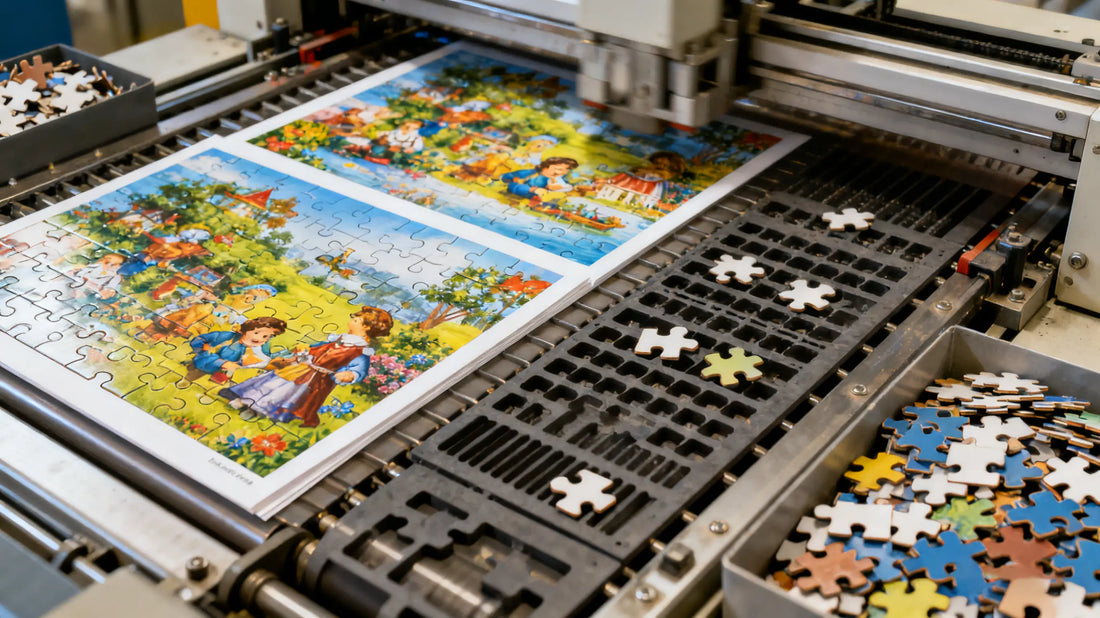
Ever Wondered How Puzzles Are Made? Here’s the Answer
Share
Have you ever sat down with a puzzle, admiring the clean cut of each piece and wondering, how are puzzles made? Behind every box of puzzles lies an intricate process that blends creativity, engineering, and precision. From the initial concept artwork to the final packaging, puzzles go through several fascinating stages before landing on your table.
In this article, we’ll take a deep dive into the journey of puzzle-making. You’ll learn about the artistry, technology, and craftsmanship that bring puzzles to life.
Table of Contents
1. The Origins of Puzzle Design
2. Step 1: Creating the Artwork
3. Step 2: Printing the Puzzle Image
4. Step 3: Mounting on Puzzle Board
5. Step 4: Cutting with Precision Tools
6. Step 5: Quality Control and Finishing
7. Step 6: Packaging and Distribution
8. Traditional Craft vs. Modern Manufacturing
9. Eco-Friendly Puzzle Production Trends
10. Final Thoughts
11. FAQ
The Origins of Puzzle Design
The journey begins with an idea. Puzzle companies often collaborate with artists, photographers, or graphic designers to choose an image that is visually appealing and challenging. Some puzzles feature breathtaking landscapes, while others highlight pop culture, artwork, or even custom photographs.
The chosen design must balance beauty and usability. If the image is too uniform, like an all-blue sky, it becomes frustrating. If it’s too chaotic, it might lose appeal. Striking the right balance is essential.
Step 1: Creating the Artwork
The artwork is the foundation of every puzzle. Once a design is selected, it undergoes digital enhancements such as color correction and resizing. For puzzles sold in different formats (500, 1000, or 2000 pieces), designers adjust the resolution to ensure clarity no matter the size.
High-resolution digital files are prepared, ensuring that every tiny detail will remain sharp when printed.
Step 2: Printing the Puzzle Image
After finalizing the artwork, it’s time to print. Puzzle images are usually printed on high-quality, thick paper using offset printing machines. These machines guarantee rich colors, durability, and resistance to fading.
The choice of ink matters as well. Non-toxic, eco-friendly inks are increasingly used to ensure safety, especially since puzzles are often handled by children.
Step 3: Mounting on Puzzle Board
Once printed, the image is glued onto a sturdy backing board, usually made of cardboard or chipboard. This mounting process is critical: if the adhesive is uneven, bubbles or wrinkles can distort the image.
The board thickness varies, but most standard puzzles use 1.5–2mm boards, balancing durability with flexibility. Premium puzzles may use thicker boards for a more luxurious feel.
Step 4: Cutting with Precision Tools
This is where the magic happens. Special steel dies (often called “cookie cutters” for puzzles) are designed to cut the board into hundreds or thousands of interlocking pieces.
Each die is handcrafted and contains hundreds of sharp metal blades arranged in unique patterns. When pressed against the mounted puzzle board with immense pressure, the die cuts cleanly through, creating perfectly interlocking pieces.
Some companies even experiment with laser cutting, producing unique piece shapes for wooden or specialty puzzles.
Step 5: Quality Control and Finishing
Not all cuts are perfect. During quality control, workers check for:
• Clean edges
• Correct number of pieces
• No missing or duplicate cuts
• Image alignment
Defective puzzles are discarded or recycled. Only those meeting strict standards make it to the packaging line.
Step 6: Packaging and Distribution
Once approved, puzzle pieces are mixed to ensure randomness, then packed into plastic bags or eco-friendly alternatives. They’re placed in boxes featuring the puzzle image, along with branding and puzzle piece count.
From there, they are distributed to retailers worldwide—or directly shipped to customers via online stores.
Traditional Craft vs. Modern Manufacturing
Historically, puzzles were cut by hand using scroll saws—a labor-intensive process producing one puzzle at a time. Today, automated die-cutting allows thousands of puzzles to be produced daily.
However, boutique puzzle makers still preserve traditional craftsmanship, offering wooden puzzles with hand-cut details. These are often considered collectibles due to their artistry.
Eco-Friendly Puzzle Production Trends
Modern consumers care about sustainability, and puzzle companies are responding. Common eco-friendly practices include:
• Using recycled cardboard for puzzle boards
• Plant-based, non-toxic inks
• Plastic-free packaging
• Biodegradable puzzle bags
Brands embracing these trends not only reduce environmental impact but also appeal to eco-conscious puzzle lovers.
Final Thoughts
So, how are puzzles made? It’s a combination of artistic vision, precision engineering, and careful craftsmanship. From concept artwork to final packaging, each stage ensures that puzzles bring joy, challenge, and satisfaction to millions of people worldwide.
The next time you open a puzzle box, you’ll know the fascinating journey behind each piece.
FAQ
1. How long does it take to make a puzzle?
Mass-produced puzzles can be made in just a few hours, while handcrafted wooden puzzles may take several days.
2. What materials are puzzles made of?
Most puzzles are made of cardboard mounted with printed paper. Premium puzzles may use wood, plastic, or foam boards.
3. Are puzzle pieces cut randomly?
Yes. Puzzle dies are designed with irregular patterns to ensure unique interlocking pieces.
4. Can puzzles be recycled?
Yes, most cardboard puzzles can be recycled, though glossy coatings may need special handling.
5. Why do some puzzles have missing pieces?
This is rare but can happen due to manufacturing or packaging errors. Most companies offer replacements if contacted.
Ready to appreciate puzzles on a whole new level? Next time you work on one, remember the artistry and craftsmanship behind each piece. If you're eager to explore more about puzzles, check out our Who Invented Puzzles? and start your next puzzle adventure today!
